Multi-Hazard WebGIS Platform for Coastal Regions
Abstract
:Featured Application
Abstract
1. Introduction
- -
- They are often dedicated to a specific site, developed around particular conditions and data streams. While frequently tailored to specific needs, their maintenance is complex and time-consuming, and often become obsolete, not resisting the advances of technology. Moreover, their application to similar systems is so time-consuming that development from scratch is commonly the solution undertaken for new deployments.
- -
- They are not designed to address multiple hazards and multiple sources of data. For systems subject to several flooding hazards sources, an integrated and individual analysis is required and the data that best fit this analysis needs to be included.
- -
- Technological constraints often hamper the usability of these platforms, making for instance the visualization and probing over the complex space- and time-varying information frequently too slow. Usually, inadequate and static designs prevent the adaptation to multiple uses (e.g., platforms tailored for management or for civil protection agencies have different requirements) and the necessary evolution to address new challenges (e.g., addressing the impact of a new construction in the area).
2. Materials and Methods
2.1. Multi-Hazard Framework for Flood and Erosion Risk in Coastal Zones
2.1.1. Methodology Description
2.1.2. Modeling and Forecasting Infrastructure
2.1.3. Multi-Source Monitoring Framework
2.2. The MOSAIC Multi-Hazard Platform
2.2.1. Concept and Main Implementation
- -
- Historical data of coastal flooding occurrences (histórico de eventos)—a statistical analysis of past events is presented here using WebGIS capabilities. In the demo below, this analysis is supported by data from newspapers;
- -
- Regional hydrodynamic forcings (forçamentos regionais)—forecasts results used to force the simulations of the observatories are shown here, for a rapid evaluation of hazardous events conditions. These forecasts are provided by external providers outside the MOSAIC project, which will allow for updates for better forcings in the future if needed. In the demo below, http://ariel.lnec.pt (accessed on 10 May 2021) is the forecast source;
- -
- Observatories (observatórios)—selection of the observatory to unlock the access to the corresponding model predictions, data, and risk products. These products are available in the following tab outputs (resultados).
2.2.2. Platform Architecture
3. Showcasing the Results: Application to the Central West Portuguese Coast
3.1. Regional Products
3.1.1. Historical Analysis of Past Flooding and Overtopping Events
- -
- Number of occurrences (número de ocorrências);
- -
- Impact on humans (imp. humanos);
- -
- Anthropic and infrastructures impact (imp. antrópicos e em infraestruturas);
- -
- Impact on natural and environmental system (imp. sistemas naturais e ambientais).
3.1.2. Regional Forcings for the Observatory Predictions
- -
- Wave climate (agitação marítima)
- –
- Significant wave height (altura significativa da onda);
- –
- Peak period (período de pico).
- -
- Tide and storm surge (maré e storm surge)
- –
- Sea level (nível do mar).
3.2. Cova-Gala Observatory
3.2.1. Overview
3.2.2. Observatory Information
- -
- Data related to field campaigns, which includes topographical and photogrammetric surveys, used to profile beaches, coastlines, defense structures toe, dunes foot, flooding and overtopping events at the selected observatory, and hydrodynamic data used to validate numerical models.
- -
- Real time data, obtained through on-site cameras, placed on each observatory. The resulting images serve as input for a Python processing algorithm, to obtain several outputs, namely the line of the offshore bar, the breaker line, the wet/dry interface line and the vegetation line. These lines are used to validate numerical models applied and validate events of overtopping or flooding. In-situ sensors are also included here.
- -
- Sentinel satellite data, composed of multiple satellite images that are processed and used to reconstruct the 3D morphology of beaches and to monitor the position of the shoreline.
- -
- Historical data of flooding and overtopping occurrences on the selected observatory (including times of occurrence, flooded area, water levels and other data).
4. Discussion
5. Conclusions
Author Contributions
Funding
Data Availability Statement
Conflicts of Interest
References
- Nicholls, R.J.; Cazenave, A.A. Sea-Level Rise and Its Impact on Coastal Zones. Science 2010, 328, 1517–1520. [Google Scholar] [CrossRef] [PubMed]
- IPCC. Climate Change 2013: The Physical Science Basis. Contribution of Working Group I to the Fifth Assessment Report of the Intergovernmental Panel on Climate Change; Stocker, T.F., Qin, D., Plattner, G.K., Tignor, M., Allen, S.K., Boschung, J., Nauels, A., Xia, Y., Bex, V., Midgley, P.M., Eds.; Cambridge University Press: Cambridge, UK; New York, NY, USA, 2013; p. 1535. [Google Scholar]
- Islam, M.A.; Mitra, D.; Dewan, A.; Akhter, S.H. Coastal multi-hazard vulnerability assessment along the Ganges deltaic coast of Bangladesh–A geospatial approach. Ocean. Coast. Manag. 2016, 127, 1–15. [Google Scholar] [CrossRef]
- Vitousek, S.; Barnard, P.L.; Fletcher, C.H.; Frazer, N.; Erikson, L.; Storlazzi, C.D. Doubling of coastal flooding frequency within decades due to sea-level rise. Sci. Rep. 2017, 7, 1399. [Google Scholar] [CrossRef] [PubMed]
- Chaumillon, E.; Bertin, X.; Fortunato, A.B.; Bajo, M.; Schneider, J.-L.; Dezileau, L.; Walsh, J.P.; Michelot, A.; Etienne, C.; Créac, A.; et al. Storm-induced marine flooding: Lessons from a multidisciplinary approach. Earth-Sci. Rev. 2017, 165, 151–184. [Google Scholar] [CrossRef] [Green Version]
- Freire, P.; Oliveira, F.S.B.F.; Oliveira, J.N.C. Coastal Flooding Process: Comparing Different Coastal Typologies Response to Extreme Hydrodynamic Conditions. J. Coast. Res. 2020, 95, 797–802. [Google Scholar] [CrossRef]
- Bruneau, N.; Fortunato, A.B.; Dodet, G.; Freire, P.; Oliveira, A.; Bertin, X. Future evolution of a tidal inlet due to changes in wave climate, Sea level and lagoon morphology (Óbidos lagoon, Portugal). Cont. Shelf Res. 2011, 31, 1915–1930. [Google Scholar] [CrossRef]
- Bertin, X.; Prouteau, E.; Letetrel, C. A significant increase in wave height in the North Atlantic Ocean over the 20th century. Glob. Planet. Chang. 2013, 106, 77–83. [Google Scholar] [CrossRef]
- Gomes, J.L.; Jesus, G.; Rogeiro, J.; Oliveira, A.; Costa, R.; Fortunato, A. Molines–towards a responsive Web platform for flood forecasting and risk mitigation. In Proceedings of the Federated Conference on Computer Science and Information Systems, Lodz, Poland, 13–16 September 2015; Volume 5, pp. 1171–1176. [Google Scholar] [CrossRef] [Green Version]
- Khalid, A.; Ferreira, C.M. Advancing real-time flood prediction in large estuaries: iFLOOD a fully coupled surge-wave automated web-based guidance system. Environ. Model. Softw. 2020, 131. [Google Scholar] [CrossRef]
- Knight, P.J.; Prime, T.; Brown, J.M.; Morrissey, K.; Plater, A.J. Application of flood risk modelling in a web-based geospatial decision support tool for coastal adaptation to climate change. Nat. Hazard. Earth Syst. Sci. 2015, 15, 1457–1471. [Google Scholar] [CrossRef] [Green Version]
- Fortunato, A.B.; Oliveira, A.; Rogeiro, J.; Costa, R.T.; Gomes, J.L.; Li, K.; Jesus, G.; Freire, P.; Rilo, A.; Mendes, A.; et al. Operational forecast framework applied to extreme sea levels at regional and local scales. J. Oper. Oceanogr. 2017, 10, 1–15. [Google Scholar] [CrossRef]
- Azevedo, A.; Fortunato, A.B.; Epifânio, B.; den Boer, S.; Oliveira, E.R.; Alves, F.L.; Jesus, G.; Gomes, J.L.; Oliveira, A. An oil risk management system based on high-resolution hazard and vulnerability calculations. Ocean. Coast. Manag. 2017, 136, 1–18. [Google Scholar] [CrossRef] [Green Version]
- Rodrigues, M.; David, L.M.; Oliveira, A.; Fortunato, A.B.; Menaia, J.; Costa, J.; Mota, T.; Rogeiro, J.; Jesus, G.; Morais, P.G.; et al. On-line monitoring of CSO: Sewer and receiving waters. In Climate Change, Water Supply and Sanitation: Risk Assessment, Management, Mitigation and Reduction; IWA Publishing: London, UK, 2015; pp. 69–74. [Google Scholar]
- Rodrigues, M.; Martins, R.; Rogeiro, J.; Fortunato, A.B.; Oliveira, A.; Cravo, A.; Jacob, J.; Rosa, A.; Azevedo, A.; Freire, P. A web-based observatory for biogeochemical assessment in coastal regions. J. Environ. Inform. 2021, in press. [Google Scholar] [CrossRef]
- Swail, V.; Grimes, S.; Pilon, P.; Canterford, R.; Barrett, C.; Simonov, Y. Early Warnings of Coastal Inundation; World Meteorological Organization: Geneva, Switzerland, 2019; Volume 68, Available online: https://public.wmo.int/en/resources/bulletin/early-warnings-of-coastal-inundation (accessed on 10 May 2021).
- Environment Agency. UK Coastal Monitoring and Forecasting (UKCMF) Service-Strategy for 2009 to 2019. Available online: https://assets.publishing.service.gov.uk/government/uploads/system/uploads/attachment_data/file/292919/geho1009brfe-e-e.pdf (accessed on 10 May 2021).
- Freire, P.; Fortunato, A.B.; Tavares, A.; Oliveira, A.; Santos, P.P. Multi-source flood risk analysis for safe coastal communities and sustainable development. In 5ª Conferência sobre Morfodinâmica Estuarina e Costeira-Livro de Resumos; Faculdade de Ciências da Universidade de Lisboa: Lisboa, Portugal, 2019; pp. 71–72. ISBN 978-989-20-9612-4. [Google Scholar]
- Barros, J.L.; Freire, P.; Perdiz, L.; Tavares, A.O. Flooding Occurrences in the Portuguese Continental Coastal Zone: A Database for the Period 1980–2018. In E-Proceedings of the 30th European Safety and Reliability Conference and 15th Probabilistic Safety Assessment and Management Conference (ESREL2020 PSAM15); Baraldi, P., di Maio, F., Zio, E., Eds.; Research Publishing Services: Tamil Venice, Italy, 2020. [Google Scholar]
- Oliveira, A.; Fortunato, A.B.; Rogeiro, J.; Teixeira, J.; Azevedo, A.; Lavaud, L.; Bertin, X.; Gomes, J.; David, M.; Pina, J.; et al. OPENCoastS: An open-access service for the automatic generation of coastal forecast systems. Environ. Model. Softw. 2020, 124, 104585. [Google Scholar] [CrossRef]
- Rogeiro, J.; Rodrigues, M.; Azevedo, A.; Oliveira, A.; Martins, J.P.; David, M.; Pina, J.; Dias, N.; Gomes, J. Running high resolution coastal models in forecast systems: Moving from workstations and HPC cluster to cloud resources. Adv. Eng. Softw. 2018, 117, 70–79. [Google Scholar] [CrossRef]
- Zhang, Y.J.; Ye, F.; Stanev, E.V.; Grashorn, S. Seamless cross-scale modeling with SCHISM. Ocean Model. 2016, 102, 64–81. [Google Scholar] [CrossRef] [Green Version]
- Roelvink, D.; Reniers, A.; Dongeren, A.; Vries, J.T.; Mccall, R.; Lescinsky, J. Modelling storm impacts on beaches, dunes and barrier islands. Coast. Eng. 2009, 56, 1133–1152. [Google Scholar] [CrossRef]
- Roelvink, D.; McCall, R.; Mehvar, S.; Nederhoff, K.; Dastgheib, A. Improving predictions of swash dynamics in XBeach: The role of groupiness and incident-band runup. Coast. Eng. 2018, 134, 103–123. [Google Scholar] [CrossRef]
- Nahon, A.; Fortunato, A.B.; Azevedo, A.; Oliveira, F.S.B.F.; Oliveira, J.N.C.; Rogeiro, J.; Jesus, G.; Oliveira, A.; Silva, P.A.; Freire, P. Implementation and validation of an operational forecasting system for nearshore hydrodynamics with OPENCoastS. In Atas das 6as Jornadas de Engenharia Hidrográfica/1as Jornadas Luso-Espanholas de Hidrografia; Instituto Hidrográfico: Lisboa, Portugal, 2020; pp. 203–206. [Google Scholar]
- Jesus, G.; Casimiro, A.; Oliveira, A. Using Machine Learning for Dependable Outlier Detection in Environmental Monitoring Systems. Trans. Cyber-Phys. Syst. 2021, in press. [Google Scholar]
- Mase, H.; Tamada, T.; Yasuda, T.; Hedges, T.S.; Reis, M.T. Wave Runup and Overtopping at Seawalls Built on Landand in Very Shallow Water. J. Waterw. Port Coast. Ocean. Eng. 2013, 139, 346–357. [Google Scholar] [CrossRef]

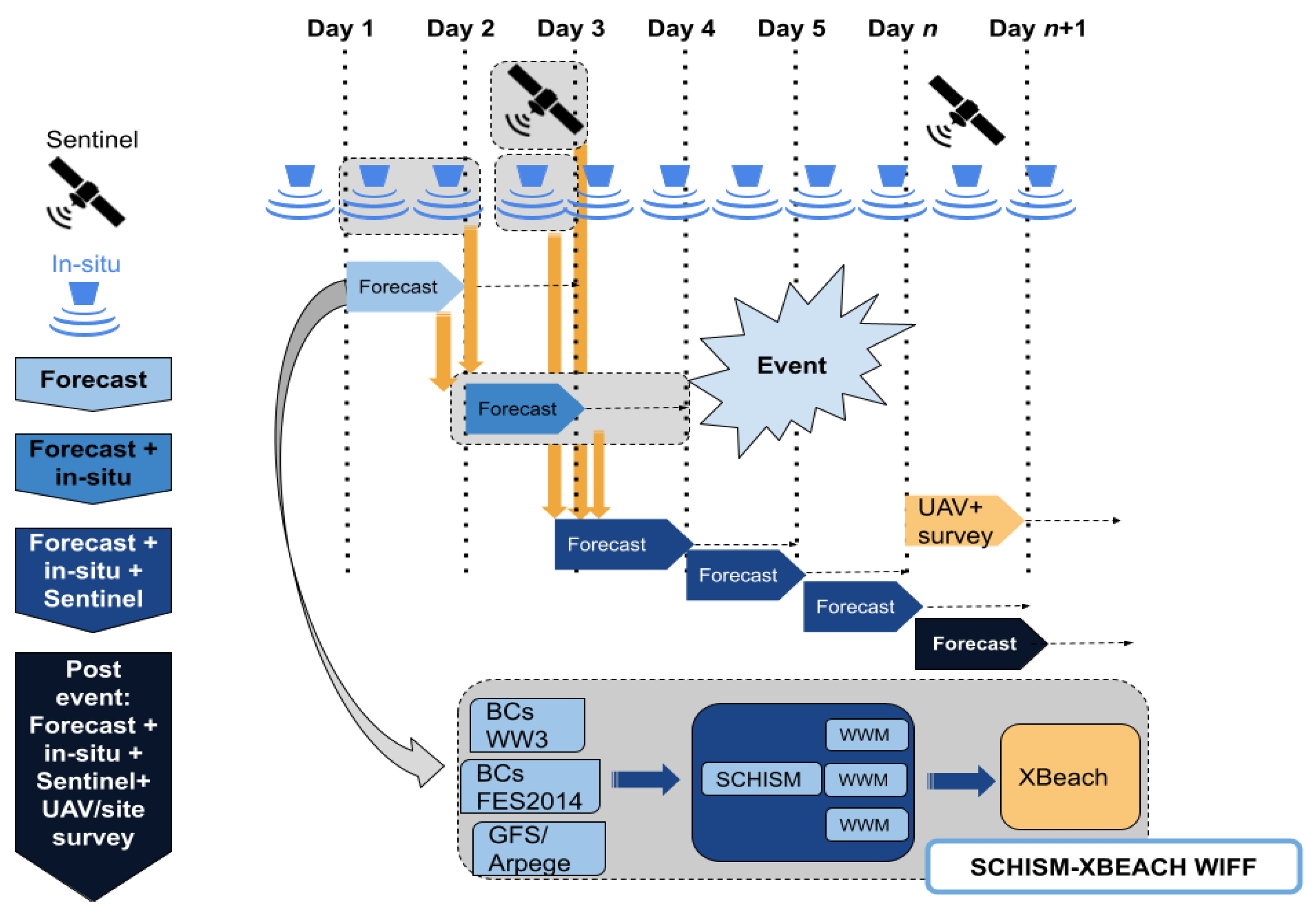
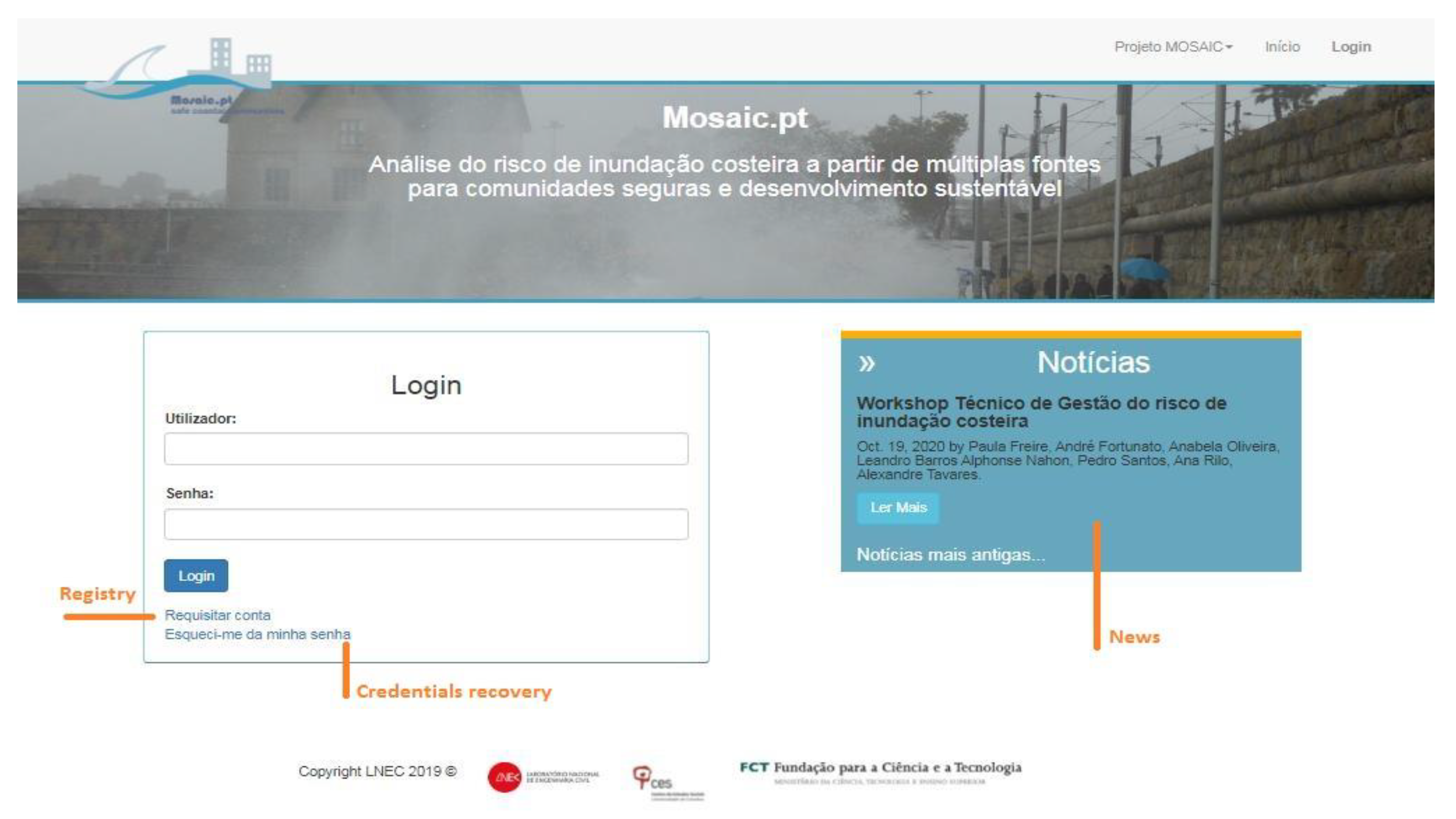

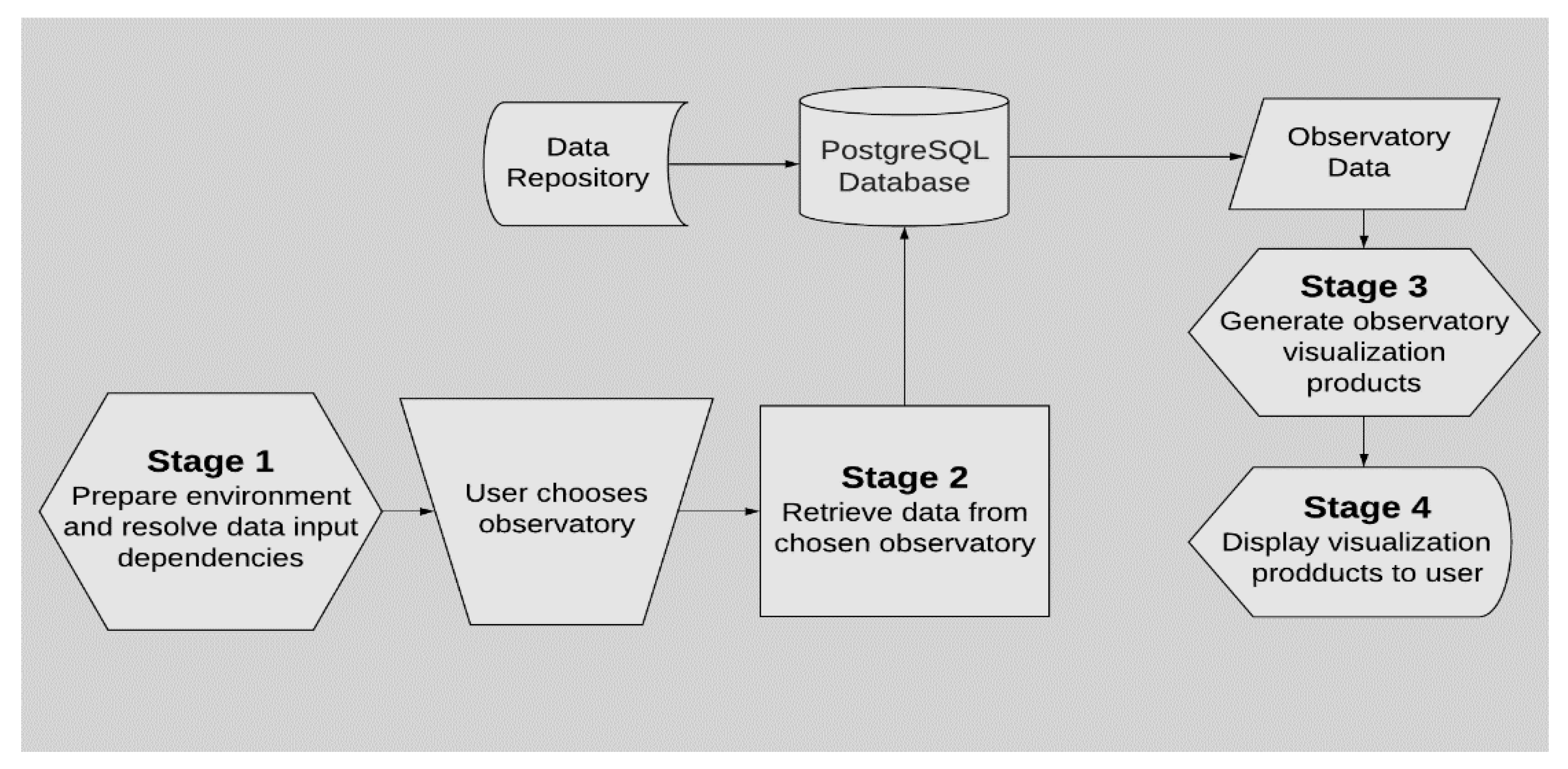
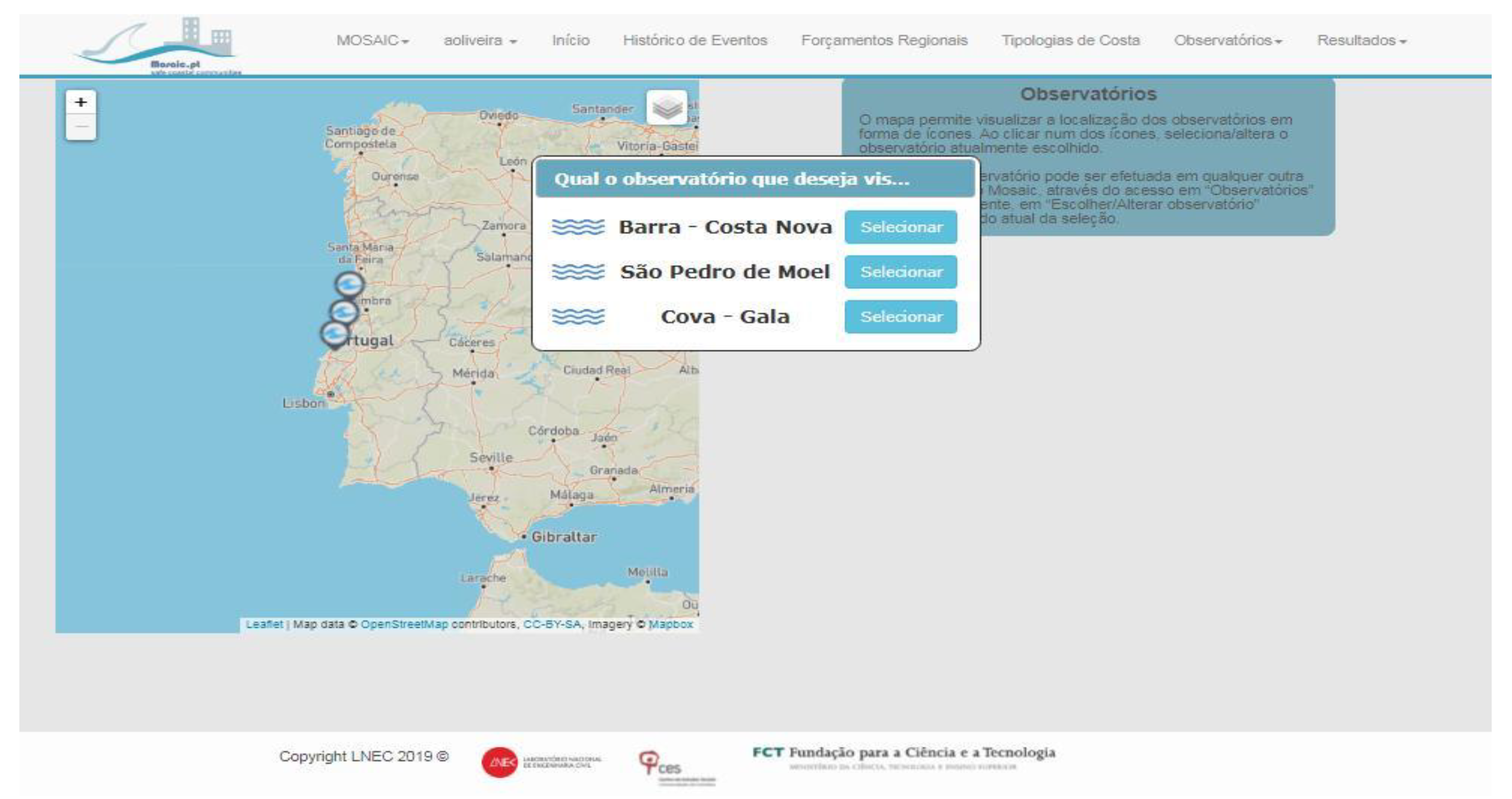
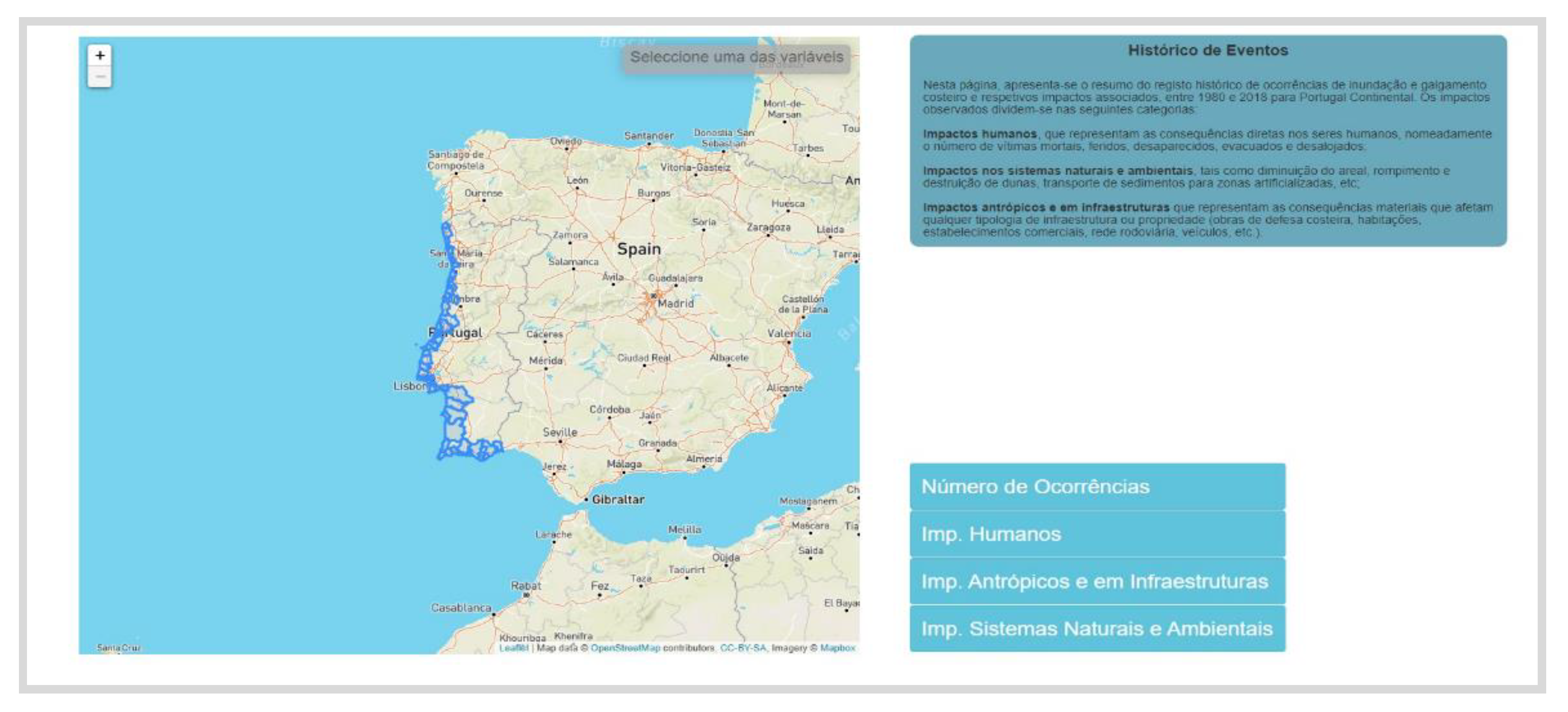
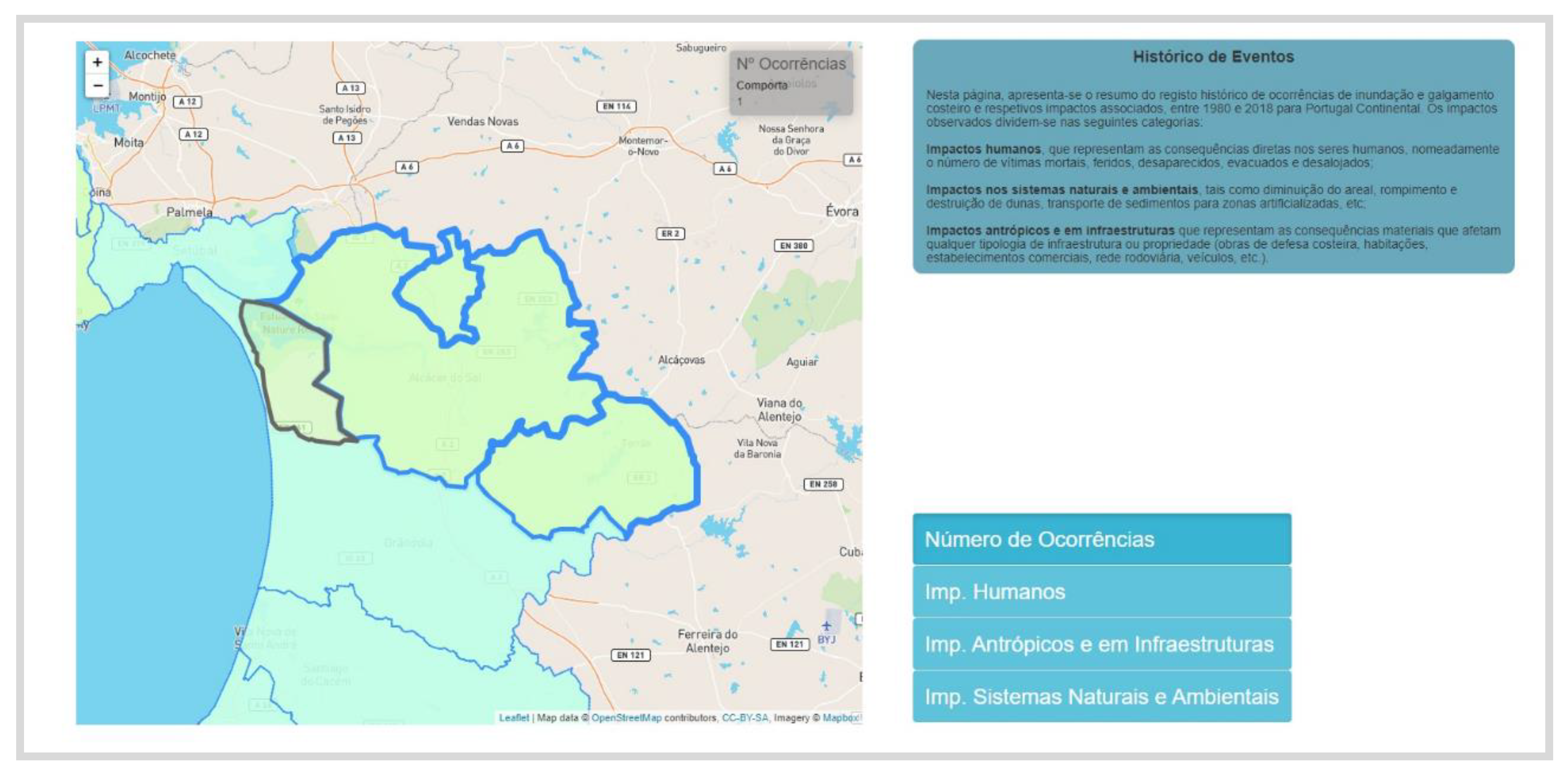
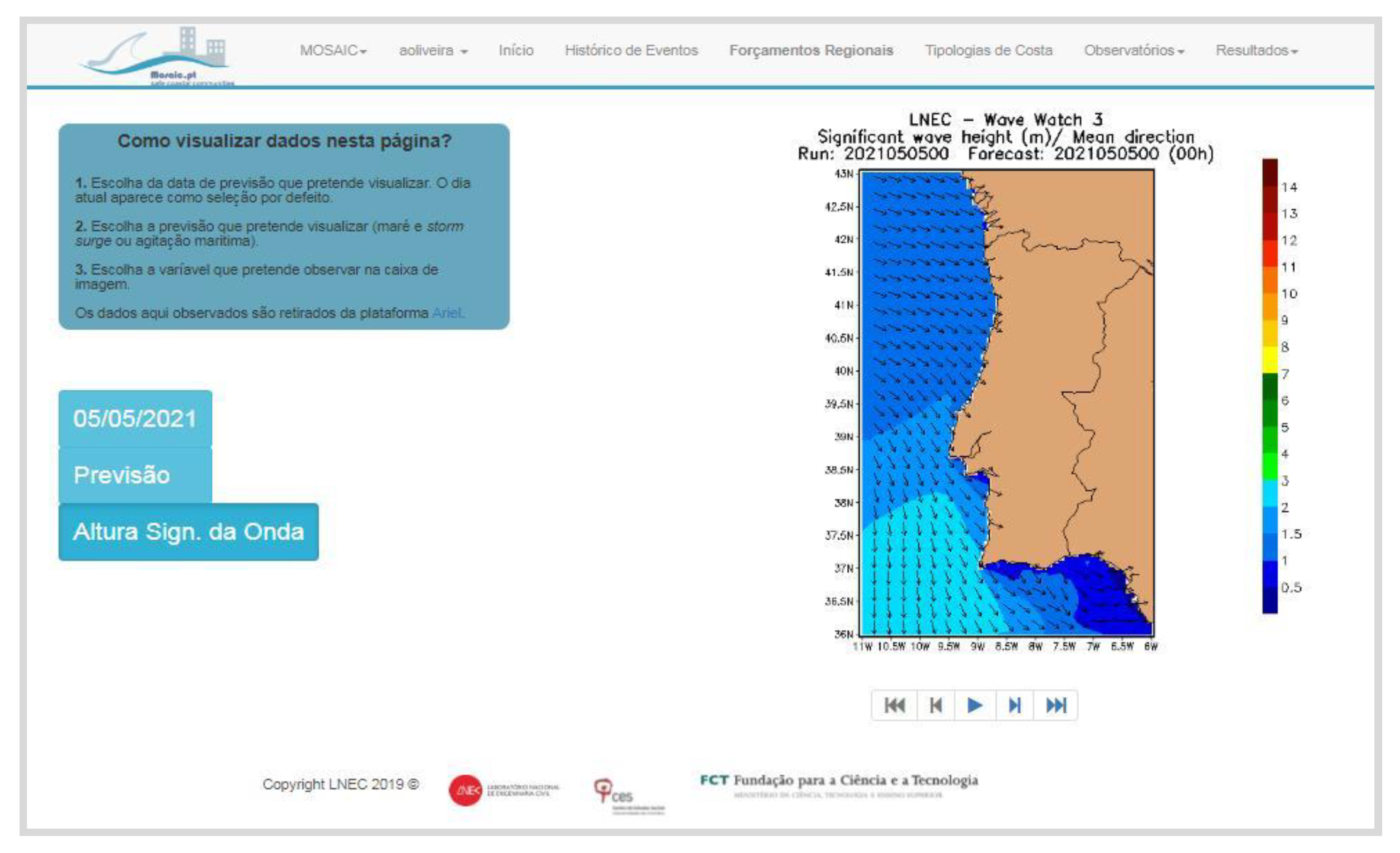
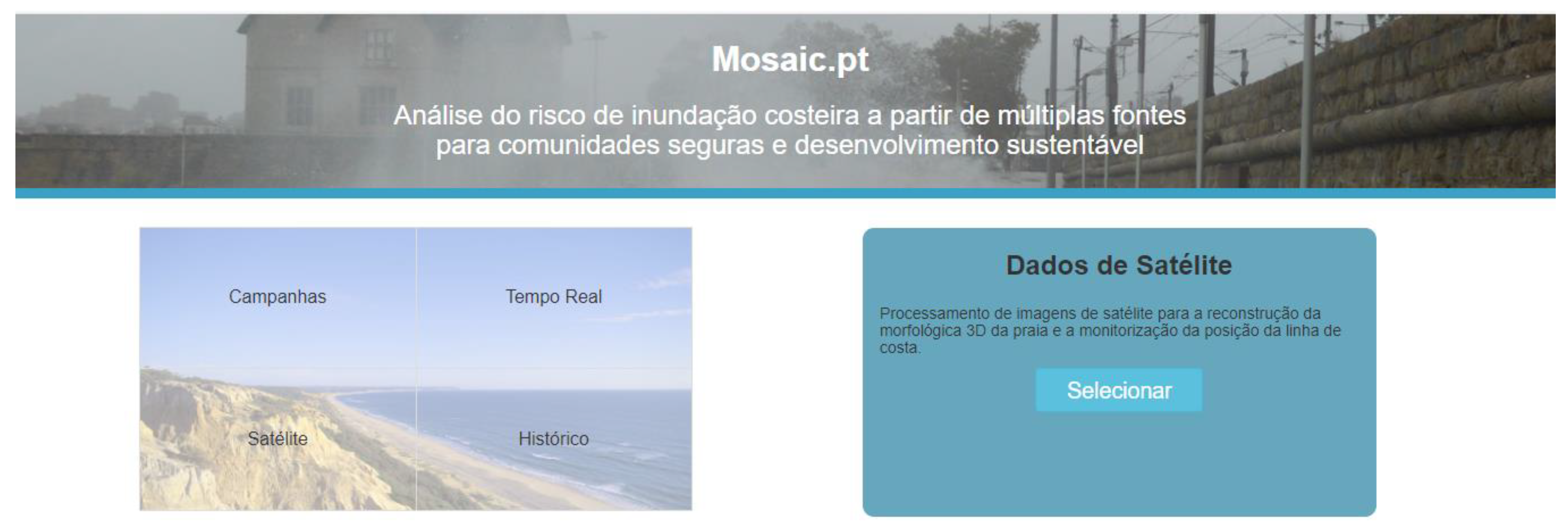
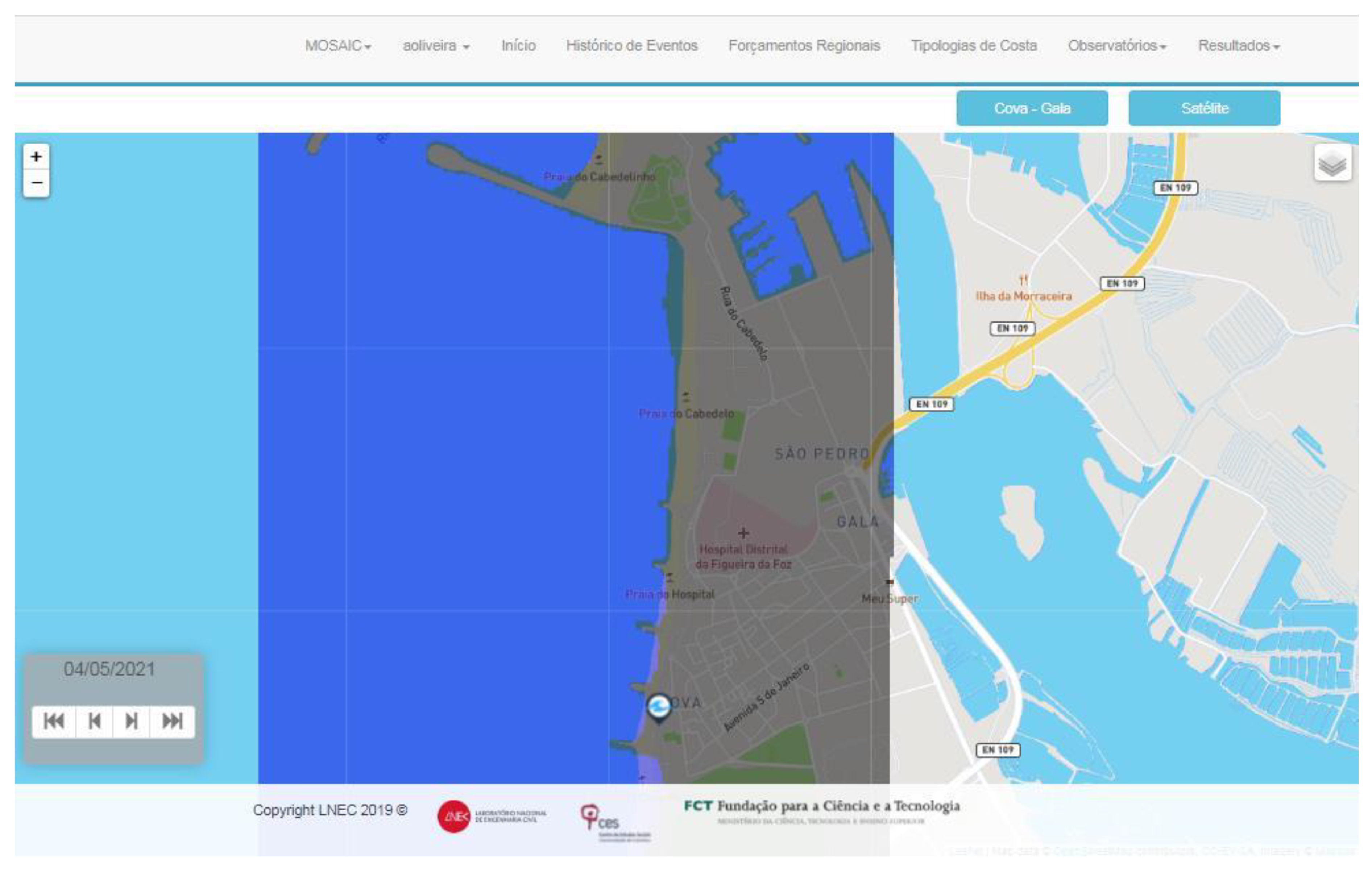

Publisher’s Note: MDPI stays neutral with regard to jurisdictional claims in published maps and institutional affiliations. |
© 2021 by the authors. Licensee MDPI, Basel, Switzerland. This article is an open access article distributed under the terms and conditions of the Creative Commons Attribution (CC BY) license (https://creativecommons.org/licenses/by/4.0/).
Share and Cite
Rocha, M.; Oliveira, A.; Freire, P.; Fortunato, A.B.; Nahon, A.; Barros, J.L.; Azevedo, A.; Oliveira, F.S.B.F.; Rogeiro, J.; Jesus, G.; et al. Multi-Hazard WebGIS Platform for Coastal Regions. Appl. Sci. 2021, 11, 5253. https://doi.org/10.3390/app11115253
Rocha M, Oliveira A, Freire P, Fortunato AB, Nahon A, Barros JL, Azevedo A, Oliveira FSBF, Rogeiro J, Jesus G, et al. Multi-Hazard WebGIS Platform for Coastal Regions. Applied Sciences. 2021; 11(11):5253. https://doi.org/10.3390/app11115253
Chicago/Turabian StyleRocha, Miguel, Anabela Oliveira, Paula Freire, André B. Fortunato, Alphonse Nahon, José L. Barros, Alberto Azevedo, Filipa S. B. F. Oliveira, João Rogeiro, Gonçalo Jesus, and et al. 2021. "Multi-Hazard WebGIS Platform for Coastal Regions" Applied Sciences 11, no. 11: 5253. https://doi.org/10.3390/app11115253
APA StyleRocha, M., Oliveira, A., Freire, P., Fortunato, A. B., Nahon, A., Barros, J. L., Azevedo, A., Oliveira, F. S. B. F., Rogeiro, J., Jesus, G., Martins, R. J., Santos, P. P., Tavares, A. O., & Oliveira, J. (2021). Multi-Hazard WebGIS Platform for Coastal Regions. Applied Sciences, 11(11), 5253. https://doi.org/10.3390/app11115253







